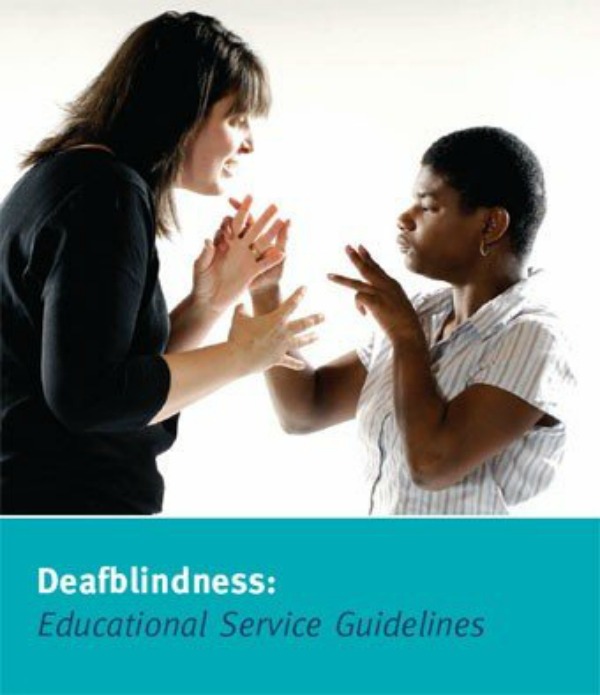Deafblindness: Educational Service Guidelines

This resource offers state and local education agencies a framework from which meaningful, appropriate programming for students who are deafblind can be developed. These guidelines identify the knowledge and skills educators need to assist their students who are deafblind reach their full potential and become successful, contributing members of our society. Developed by leaders in the field of deafblindness, guide offers insight on implications of combined vision and hearing loss on learning and the need for specialized assessment, program planning and service delivery.
Best Practices: Designed for educational administrators at all levels – state, local and program. Guide addresses key aspects of addressing student communication needs, building a staff and developing a team approach.
Chapter 1: Foundations
This chapter describes the skills and knowledge that educators must possess in order to teach children who are deafblind. This group of children presents very diverse and complex educational needs. Critical areas of educational programming need to address the development of communication, appropriate assessment, and working with families.
Chapter 2: Educational Personnel
The student who is deafblind is usually served by a large, diverse educational team. The term educational personnel refers to those persons providing services within an educational setting. Programs serving students with deafblindness should have appropriately qualified team members and provide ongoing supervision, mentoring, and professional development. To ensure that quality services are provided, at least one member of this team (a deafblind specialist) should have an in-depth knowledge and expertise in deafblindness adequate to assure equal access to the student who is deafblind to all aspects of the learning environment. This chapter presents the issues that should be considered by educational personnel who serve students who are deafblind.
Chapter 3: Assessment
The assessment of students who are deafblind is challenging. There are no standardized tests specifically designed for deafblindness. The reason is that there is no typical student who is deafblind who can serve as the norm upon which to base assessment or evaluation tools. Often, students have varying degrees of sensory losses and additional cognitive, physical and emotional challenges. Each of these factors and their combined impact must be carefully considered, and the student should be assessed in a holistic way. This chapter presents the factors that must be considered in order for an assessment to be a fair appraisal of students’ abilities, challenges, and priorities for instruction.
Chapter 4: Services and Placement Options
This chapter provides an overview of the issues surrounding services and placement options for children who are deafblind. The Individuals with Disabilities Education Improvement Act (IDEA) of 2004 requires that an array of services and placement options be available to students with disabilities. The goal of placement in the least restrictive environment (LRE) will only be realized when the student has full access to the curriculum and educational environment in his/her communication forms, has authentic interactions with both peers and professional personnel, and achieves high educational performance standards (National Association of State Directors of Special Education [NASDSE], 2006, p. 51). The services provided for students who are deafblind must be well coordinated and implemented in a collaborative manner to meet the identified needs of the student.
Chapter 5: Supportive Structure and Administration
Deafblindness is a low-incidence disability; therefore, it is important that state and local administrators work collaboratively and creatively with existing resources and develop new resources when necessary to expand state capacity and to assure that students have quality IEPs/ITPs developed by teams that have expertise in deafblindness. A common challenge is that state and local educational administrators are often unaware that some of their special education students are deafblind because those students, especially when they have multiple disabilities, are counted under different categories of disabilities.
Appendix A
Competencies for Teachers of Learners Who Are Deafblind (1997) B. McLetchie & M. Riggio, Eds. These are statements of knowledge and skills required for teachers of learners who are deafblind. At the core of the teacher competencies is the teacher’s ability to build a strong, trusting, personal relationship with the learner. Based upon a trusting relationship, teachers can use their specialized competencies in deafblindness to assist the learner in developing his or her own personal and social competence.
Appendix B
Excerpt from: The NTAC Outcome and Performance Indicators: A System for Documenting Outcomes for Children and Youth with Deaf-Blindness, their Families, and the Service Providers and Systems that Serve Them.
Appendix C
Recommendations on the Training of Interveners for Students who are Deafblind (2004) Alsop, L. et. al. This document outlines training practices and competencies recommended for intervener training. The document addresses many of the issues identified by the Intervener Task Force and later the Community of Practice Focusing on Interveners and Paraprofessionals. It includes a common understanding of the definition and role of an intervener, a list of recommended competencies, levels of learning for staff development and training, recommended training practices and a checklist of considerations for developing an intervener training system.
Appendix D
Competencies for Training Interveners to Work with Children/Students with Deafblindness (2004) Alsop, L. This is a copy of the validation survey used to determine the appropriateness of each competency listed for interveners working one-to-one with students who are deafblind.
